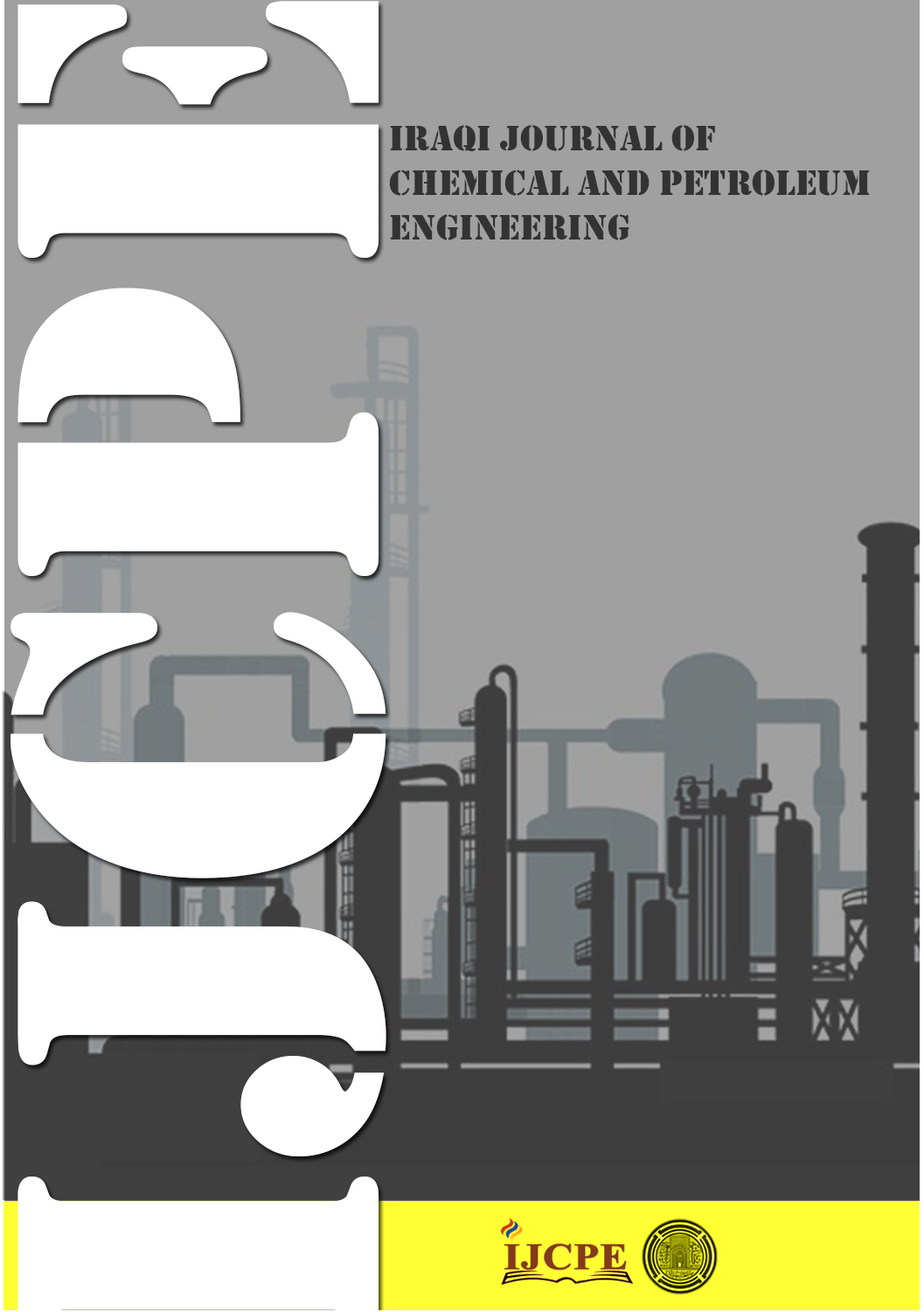Geomechanical properties evaluation of Mauddud formation based on experimental measurements and well log data
DOI:
https://doi.org/10.31699/IJCPE.2025.3.13Keywords:
Rock Mechanical Properties Evaluation; Experimental Rock Evaluation; UCS; X-Ray Diffraction; Scanning Electron MicroscopyAbstract
Mauddud formation is one of the most prominent formations in Northeastern Iraq due to its significant hydrocarbon reserves, making accurate geomechanical characterization essential for safe drilling operations and informed development planning. This study constructs a calibrated post-drill one dimensional mechanical earth model (1D-MEM) for selected wells, levering Techlog software to integrate rock mechanical data, image logs, multi-arm caliper measurements, conventional well logs, drilling reports, and core analyses. The methodology provides a detailed workflow for estimating geomechanical properties from log and image analysis to model calibration. Validation of the 1-D MEM performed through cross-comparison with direct measurements, ensuring the reliability of the predicted stress and strength profile. Laboratory and field data including pore pressure measurements using DST method, destructive and non-destructive mechanical tests, scanning electron microscopy (SEM), thin section test (TS), X-ray diffraction test (XRD), and energy-dispersive X-ray spectroscopy (EDS) have all been used for analyzation and calibration process. These datasets enhance the MEM parameters and support the derivation of empirical correlation specific to the Mauddud Formation. Derived correlations include compressional-shear slowness velocity, slowness velocity- bulk density, compression slowness-unconfined compressive strength (UCS), and the Young's modulus to UCS correlation. Results show that mineralogical composition particularly porosity and calcite content have a dominant influence on formation strength with high porosity, low calcite intervals resulting in the lowest UCS values.
Received on 16/01/2025
Received in Revised Form on 06/04/2025
Accepted on 10/04/2025
Published on 30/09/2025
References
[1] N. Cross et al., “Reservoir description of a mid-Cretaceous siliciclastic-carbonate ramp reservoir: Mauddud Formation in the Raudhatain and Sabiriyah fields, North Kuwait,” GeoArabia, vol. 15, no. 2, pp. 17–50, 2010, https://doi.org/10.2113/geoarabia150217
[2] F. N. Sadooni and A. S. Alsharhan, “Stratigraphy, microfacies, and petroleum potential of the Mauddud Formation (Albian–Cenomanian) in the Arabian Gulf basin,” AAPG Bulletin., vol. 87, no. 10, pp. 1653–1680, Oct. 2003, https://doi.org/10.1306/04220301111
[3] W. G. AL-mutury, R. A. AL-Muhammad, and K. Al-Bayatee, “Tectonostratigraphy of Lower Cretaceous in Southern Iraq,” Iraqi National Journal of Earth Science, vol. 10, no. 2, pp. 29–44, 2010.
[4] M. J. Faisal and T. A. Mahdi, “Geological model of Mauddud Formation in Badra Oilfield,” The Iraqi Geological Journal, pp. 58–67, 2020, https://doi.org/10.46717/igj.53.1a.R4.2020.01.28
[5] I. Ghafor, A. Fatah, and A. A. L. Khafaf, “Biostratigraphy and Microfacies of the Mauddud Formation (Late Albian–Early Cenomanian) in Musaiyib Well No. 1, Central Iraq,” Iraqi Bulletin of Geology and Mining, vol. 19, no. 2, pp. 37–56, 2023, https://doi.org/10.59150/ibgm1902a03
[6] K. A. Kareem, “OPTIMIZATION OF WATER INJECTION FOR BADRA OIL FIELD,” vol. 53, no. 1, pp. 13–28, 2020, The Iraqi Geological Journal, https://doi.org/10.46717/igj.53.1B.2Rz-2020-03-02
[7] S. Z. Jassim and J. C. Goff, Geology of Iraq. DOLIN, sro, distributed by Geological Society of London, 2006.
[8] M. J. Faisal and T. A. Mahdi, “Diagenetic processes overprint and pore types of Mauddud formation, Badra oil field, Central Iraq,” Iraqi Journal of Science., vol. 61, no. 6, pp. 1353–1361, 2020, https://doi.org/10.24996/ijs.2020.61.6.13
[9] N. Jasim, S. M. Hamd-Allah, and H. Abass, “Evaluation of geomechanical properties for tight reservoir using uniaxial compressive test, ultrasonic test, and well logs data,” Petroleum and Coal, vol. 62, no. 2, pp. 329–340, 2020.
[10] A. Mockovciakova and B. Pandula, “Study of the relation between the static and dynamic moduli of rocks,” Metalurgija, vol. 42, no. 1, pp. 37–39, 2003.
[11] W. Fei, B. Huiyuan, Y. Jun, and Z. Yonghao, “Correlation of dynamic and static elastic parameters of rock,” Journal of Geotechnical Engineering, vol. 21, no. 04, pp. 1551–1560, 2016.
[12] M. Salah, A. Abdel-Meguid, B. Crane, S. Squires, and L. Matzar, “Geomechanical Evaluation Enabled Stimulation Optimization of Apollonia Tight Chalk Egypt,” in SPWLA Annual Logging Symposium, 2017.
[13] M. K. Bandara and N. J. Al-Ameri, “Wellbore Instability Analysis to Determine the Safe Mud Weight Window for Deep Well, Halfaya Oilfield,” Iraqi Geological Journal, vol. 57, no. 1D, pp. 153–173, 2024, https://doi.org/10.46717/igj.57.1D.13ms-2024-4-23
[14] A. F. Zaidan, F. A. Hadi, and M. Klempa, “Investigation of Wellbore Instability in Southern Rumaila Oil Field” Iraqi Journal of Chemical and Petroleum Engineering, vol. 25, no. 2, pp. 17–31, 2024, https://doi.org/10.31699/IJCPE.2024.2.2
[15] A. K. Abbas, H. H. Dahm, R. E. Flori, and M. Alsaba, “Laboratory Measurements of Petrophysical and Geomechanical Properties for Zubair Sandstone Formation in Southern Iraq,” in ARMA US Rock Mechanics/Geomechanics Symposium, p. ARMA-2018.
[16] B. Nagham Jasim Fayadh and S. M. Hamd-Allah Hazim H Abass, “Implication of Geomechanical Evaluation on Tight Reservoir Development / Sadi Reservoir Halfaya Oil Field.” the Requirements for The Degree of Doctorate of Philosophy in Petroleum Engineering University of Baghdad. 2020, http://dx.doi.org/10.13140/RG.2.2.13608.80640
[17] H. S. A. Almalikee, “Mechanical Earth Model (1D) to optimize high angle wells design in Rumaila oilfield, Southern Iraq,” Collage of Science University of Basrah, pp. 3–4, 2020.
[18] J. P. Davies and D. K. Davies, “Stress-dependent permeability: characterization and modeling,” SPE Annual Technical Conference and Exhibition, vol. 6, no. 02, pp. 224–235, 2001. https://doi.org/10.2118/71750-PA
[19] H. King et al., “Microstructural investigation of stress-dependent permeability in tight-oil rocks,” Petrophysics, vol. 59, no. 01, pp. 35–43, 2018.
[20] G. Muktadir, M. Amro, N. Kummer, C. Freese, and K. Abid, “Application of x-ray diffraction (Xrd) and rock–eval analysis for the evaluation of middle eastern petroleum source rock,” Energies, vol. 14, no. 20, p. 6672, 2021. https://doi.org/10.3390/en14206672
[21] V. Kumar, C. H. Sondergeld, and C. S. Rai, “Nano to macro mechanical characterization of shale,” in SPE Annual Technical Conference and Exhibition, SPE, 2012, p. SPE-159804. https://doi.org/10.2118/159804-MS
[22] J. Mason, J. Carloni, A. Zehnder, S. P. Baker, and T. Jordan, “Dependence of micro-mechanical properties on lithofacies: Indentation experiments on Marcellus shale,” in SPE/AAPG/SEG Unconventional Resources Technology Conference, URTEC, 2014, p. URTEC-1922919. https://doi.org/10.15530/URTEC-2014-1922919
[23] H. Yu, W. Zheng, X. Cui, and J. Zhou, “Influence of Mineralogical Characteristics on Mechanical Properties of Montney Tight Formations Using Instrumented Indentation Test and SEM–EDS Analysis,” Rock Mechanics and Rock Engineering, vol. 57, no. 10, pp. 8777–8794, 2024, https://doi.org/10.1007/s00603-024-04004-3
[24] R. Plumb, S. Edwards, G. Pidcock, D. Lee, and B. Stacey, “The mechanical earth model concept and its application to high-risk well construction projects,” in SPE/IADC Drilling Conference and Exhibition, SPE, 2000, p. SPE-59128. https://doi.org/10.2118/59128-MS
[25] M. Aman, D. N. Espinoza, A. G. Ilgen, J. R. Major, P. Eichhubl, and T. A. Dewers, “CO2‐induced chemo‐mechanical alteration in reservoir rocks assessed via batch reaction experiments and scratch testing,” Greenhouse Gases: Science and Technology, vol. 8, no. 1, pp. 133–149, 2018, https://doi.org/10.1002/ghg.1726
[26] A. Ihsan, N. Jasim, and A.- Ameri, “Identifying the high potential zones for hydraulic fracture propagation / Eastern Baghdad field,” Iraqi Journal of Chemical and Petroleum Engineering, vol. 25, no. 3, pp. 135–151, 2024. https://doi.org/10.31699/IJCPE.2024.3.15
[27] A. K. AlHusseini and S. M. Hamed-Allah, “Estimation Pore and Fracture Pressure Based on Log Data; Case Study: Mishrif Formation/Buzurgan Oilfield at Iraq,” Iraqi Journal of Chemical and Petroleum Engineering, vol. 24, no. 1, pp. 65–78, 2023, https://doi.org/10.31699/ijcpe.2023.1.8
[28] J. J. Zhang “Applied Petroleum Geomechanics”. 2020. https://doi.org/10.1016/C2017-0-01969-9
[29] D. Hettiaratchi, “Theoretical soil mechanics and implement design,” Soil and Tillage Research, vol. 11, no. 3–4, pp. 325–347, 1988, https://doi.org/10.1016/0167-1987(88)90005-0
[30] Z. U. G, “An overview of pore pressure prediction using seismically derived velocities,” Geology and Mining Research, vol. 7, no. 4, pp. 31–40, 2015, https://doi.org/10.5897/JGMR15.0218
[31] B. A. Eaton, “The equation for geopressured prediction from well logs,” in SPE Annual Technical Conference and Exhibition, SPE, 1975, p. SPE--5544. https://doi.org/10.2118/5544-MS
[32] K. Terzaghi, Theoretical soil mechanics. 1943.
[33] J. Zhang, “Pore pressure prediction from well logs: Methods, modifications, and new approaches,” Earth-Science Reviews, vol. 108, no. 1–2, pp. 50–63, 2011. https://doi.org/10.1016/j.earscirev.2011.06.001
[34] B. A. Eaton, “Fracture gradient prediction and its application in oilfield operations,” Journal of Petroleum Technology, vol. 21, no. 10, pp. 1353–1360, 1969, https://doi.org/10.2118/2163-PA
[35] P. A. Charlez, “The concept of mud weight window applied to complex drilling,” in SPE Annual Technical Conference and Exhibition, SPE, 1999, p. SPE-56758. https://doi.org/10.2118/56758-MS
[36] A. R. Najibi, M. Ghafoori, G. R. Lashkaripour, and M. R. Asef, “Reservoir geomechanical modeling: In-situ stress, pore pressure, and mud design,” Journal of Petroleum Science and Engineering, 2017, https://doi.org/10.1016/j.petrol.2017.01.045
[37] A. M. Abdulaziz, H. L. Abdulridha, A. S. A. Dahab, S. Alhussainy, and A. K. Abbas, “3D mechanical earth model for optimized wellbore stability, a case study from South of Iraq,” Journal of Petroleum Exploration and Production Technology, vol. 11, no. 9, pp. 3409–3420, 2021. https://doi.org/10.1007/s13202-021-01255-6
[38] R. H. Allawi and M. S. Al-Jawad, “Wellbore instability management using geomechanical modeling and wellbore stability analysis for Zubair shale formation in Southern Iraq,” Journal of Petroleum Exploration and Production Technology, vol. 11, pp. 4047–4062, 2021. https://doi.org/10.1007/s13202-021-01279-y
[39] H. Xu et al., “Characterization of rock mechanical properties using lab tests and numerical interpretation model of well logs,” Mathematical Problems in Engineering, vol. 2016, no. 1, p. 5967159, 2016. http://dx.doi.org/10.1155/2016/5967159
[40] F. H. Alshibli and A. A. Alhaleem, “Using One-Dimensional Geomechanical Model for Determining the Safe Wellbore Orientation of Zubair Reservoir, Southern Iraq,” The Iraqi Geological Journal, vol. 56, no. 2, pp. 115–134, 2023, https://doi.org/10.46717/igj.56.2C.9ms-2023-9-15
[41] C. Chang, M. D. Zoback, and A. Khaksar, “Empirical relations between rock strength and physical properties in sedimentary rocks,” Journal of Petroleum Science and Engineering, vol. 51, no. 3–4, pp. 223–237, 2006, https://doi.org/10.1016/j.petrol.2006.01.003
[42] A. Amani and K. Shahbazi, “Prediction of Rock Strength using Drilling Data and Sonic Logs,” International Journal of Computer Applications, vol. 81, no. 2, pp. 5–10, 2013, https://doi.org/10.5120/13982-1986
[43] “Schlumberger,” Limited. Techlog 2015.3 User Guide. Schlumberger software, 2015.
[44] C. Chang, M. D. Zoback, and A. Khaksar, “Empirical relations between rock strength and physical properties in sedimentary rocks,” Journal of Petroleum Science and Engineering, vol. 51, no. 3–4, pp. 223–237, 2006. https://doi.org/10.1016/j.petrol.2006.01.003
[45] A. S. Dahab, A. M. Abdulaziz, A. Manhalawi, A. K. Abbas, and N. AL-Husseini, “Managing wellbore instability through geomechanical modeling and wellbore stability analysis,” 54th, U.S. Rock Mechanics / Geomechanics Symposium, no. December 2020.
[46] M. D. Zoback et al., “Determination of stress orientation and magnitude in deep wells,” International Journal of Rock Mechanics and Mining Sciences, vol. 40, no. 7–8, pp. 1049–1076, 2003, https://doi.org/10.1016/j.ijrmms.2003.07.001
[47] D. Moos and M. D. Zoback, “Utilization of observations of wellbore failure to constrain the orientation and magnitude of crustal stresses: application to continental, Deep Sea Drilling Project, and Ocean Drilling Program boreholes,” Journal of Geophysical Research: Solid Earth, Res. Solid Earth, vol. 95, no. B6, pp. 9305–9325, 1990. https://doi.org/10.1029/JB095iB06p09305
[48] M. M. C. Carafa, G. Tarabusi, and V. Kastelic, “SHINE: Web application for determining the horizontal stress orientation,” Computers & Geosciences, vol. 74, pp. 39–49, 2015. https://doi.org/10.1016/j.cageo.2014.10.001
[49] N. Ural, “The significance of scanning electron microscopy (SEM) analysis on the microstructure of improved clay: An overview,” Open Geosciences, vol. 13, no. 1, pp. 197–218, 2021. https://doi.org/10.1515/geo-2020-0145
[50] K. Akhtar, S. A. Khan, S. B. Khan, and A. M. Asiri, “Scanning electron microscopy: Principle and applications in nanomaterials characterization”. Springer, 2018. https://doi.org/10.1007/978-3-319-92955-2_4
[51] P. Echlin, “Handbook of sample preparation for scanning electron microscopy and X-ray microanalysis” Springer Science & Business Media, 2011.
[52] D. S. Su, B. Zhang, and R. Schlögl, “Electron Microscopy of Solid Catalysts- Transforming from a Challenge to a Toolbox,” Chemical Reviews, vol. 115, no. 8, pp. 2818–2882, 2015. https://doi.org/10.1021/cr500084c
[53] N. J. Al-Ameri, S. M. Hamd-Allah, and H. H. Abass, “Investigating geomechanical considerations on suitable layer selection for hydraulically fractured horizontal wells placement in tight reservoirs,” in Abu Dhabi International Petroleum Exhibition and Conference, SPE, 2020, p.D012S116R166. https://doi.org/10.2118/203249-MS
[54] M. Ermrich and D. Opper, “X-Ray powder diffraction” XRD for The Analyst, pp. 63–85, 2011.
[55] B. S. Saini and R. Kaur, “X-ray diffraction,” Handb. Mod. Coat. Technol. Adv. Charact. Methods, pp. 85–141, 2021, https://doi.org/10.1016/B978-0-444-63239-5.00003-2
[56] Schlumberger, “Techlog Technical Manual,” 2015.
[57] R. Edjo-Minko, I. B. M. Gbambie, M. Vasconcelos, J. M. A. Essi, M. Amar, and M. F. M. Essi, “3D depth estimation of Mingo’o’s iron mineralization from outcrop data and geophysical analysis (South Cameroon, northern edge of the Congo Craton),” Brazilian Journal of Geology, vol. 54, no. 2, p. e20240020, 2024. https://doi.org/10.1590/2317-4889202420240020
Downloads
Published
Issue
Section
License
Copyright (c) 2025 The Author(s). Published by College of Engineering, University of Baghdad.

This work is licensed under a Creative Commons Attribution 4.0 International License.













